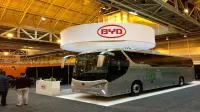Recharge Wrap-up: BYD debuts electric coach bus, decarbonized gas would help CA meet GHG goals

BYD has unveiled its all-electric coach bus. The BYD C9, as it’s called, is 40 feet long and accommodates 47 passengers. As the world’s first long-range all-electric coach, the BYD C9 can travel over 190 miles on a single charge. “I don’t think anybody thought they would see a viable electric coach solution for a few more years,” says BYD Coach & Bus Vice President of Sales, Macy Neshati. BYD will release two more electric coach buses this year: the 45-foot, three-axle C10 and the 23-foot C6.
Securing America’s Future Energy (SAFE) is accepting applications for its 2015 Energy Security Prize. The Energy Security Prize program awards companies who create technology and innovations that help end dependence on foreign oil. This year’s prize will go toward technology that is expected to come to market within the next five years. Applicants will be judged by potential oil displacement, competitive advantages over existing technology and several other criteria. The grand prize winner will receive $125,000, with second and third place getting $35,000 and $15,000, respectively. Submissions are due by April 10, 2015, and winners will be announced on June 23, 2015.
A new study suggests that low-carbon gas fuels could help California reach its greenhouse gas reduction goals. The study, put forth by Energy and Environmental Economics (E3) says that using decarbonized gas like biogas, hydrogen, and certain renewable synthetic gases could lessen impact on climate while still using existing pipeline infrastructure. For automotive purposes, the study shows that electrification with or without the use of decarbonized gas fuels would help reduce harmful emissions. Decarbonized gas, though, “may be easier and could be less costly to implement in some sectors than a high electrification strategy,” says Rodger Schwecke of the Southern California Gas Company. See the full report, or read more at Green Car Congress or in the press release below.
Comparison of Electrification, Mixed-energy Scenarios
LOS ANGELES, Jan. 27, 2015 /PRNewswire/ — As California policymakers move toward environmentally focused energy goals, including increased reliance on renewable sources, a new study by Energy Environmental Economics (E3) consulting suggests that low-carbon gas fuels are a viable option for meeting California’s greenhouse gas (GHG) reduction goals and can simultaneously help achieve pollution emission reduction targets.
Low-carbon gas fuels or “decarbonized gas” refers to gaseous fuels with a net-zero, or very low, greenhouse gas impact on the climate. These include fuels such as biogas, hydrogen and renewable synthetic gases produced with low lifecycle GHG emission approaches.
“California needs multiple energy options that deliver choice to our customers and put our state in the best position to successfully achieve its goals. Natural gas is a clean, abundant and affordable energy source that can help California address climate change and reduce smog, while supporting a strong economy,” said Rodger Schwecke, vice president of customer solutions for SoCalGas.
The report examines the potential role of decarbonized gas fuels, and the existing gas pipeline infrastructure, to help meet California’s long-term climate goals. It compares two “technology pathway” scenarios for meeting the state’s goal of reducing GHG emissions: an electrification scenario, where all energy end uses are electrified and powered by renewable electricity; and a multi-energy framework, where both electricity and decarbonized gas fuels play significant roles in California’s energy supply.
“The study concludes that a technology pathway for decarbonized gas could help meet the state’s GHG reduction goals and may be easier and could be less costly to implement in some sectors than a high electrification strategy. It was prepared by E3, a leading consulting firm which has expertise in the electricity and natural gas industries and conducts emissions studies for several state agencies.
“The findings point to the need for a significant program of research and development to make decarbonized gas a reality and allow consumers, businesses and policymakers greater flexibility and choice,” said Schwecke.
Four key findings suggest that decarbonized gases distributed through the state’s existing pipeline network are complementary with a low-carbon electrification strategy by addressing critical challenges to California’s transition to a decarbonized energy supply.
– First, decarbonized pipeline gas can help to reduce emissions in sectors that are for technical or customer-acceptance reasons difficult to electrify: 1) industrial end uses, such as process heating, (2) heavy duty vehicles, and (3) residential and commercial uses, such as cooking, and existing space and water heating.
– Second, the production of decarbonized gas from electricity could play an important role in integrating variable renewable generation by producing gas when renewables are generating power, and then storing the gas in the pipeline distribution network for when it is needed.
– Third, a transition to decarbonized pipeline gas would enable continued use of the state’s existing gas pipeline distribution network, eliminating the need for new energy delivery infrastructure – dedicated hydrogen pipelines or additional electric transmission and distribution capacity – to meet the 2050 GHG target.
– Fourth, decarbonized gas technologies would help diversify the technology risk associated with heavy reliance on a limited number of decarbonized energy carriers, and allow consumers, businesses and policymakers greater flexibility and choice.




